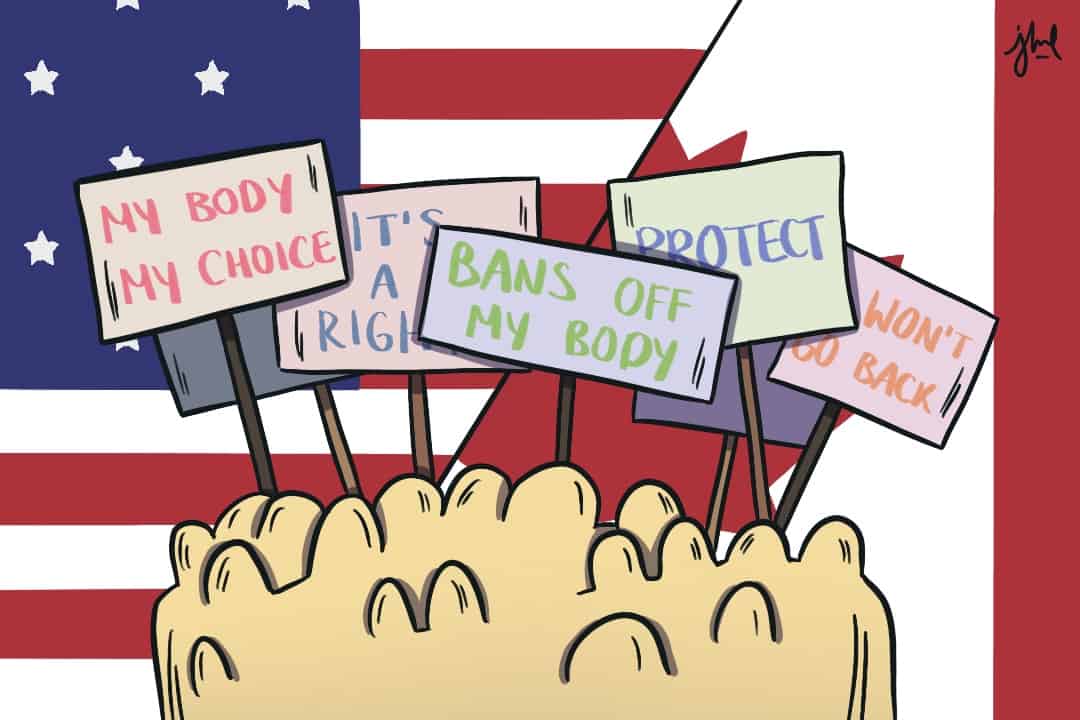On June 24, the United States Supreme Court overturned Roe v Wade — its 1973 ruling that restrictive abortion laws infringe upon womens’ right to privacy under the US Constitution. The decision effectively nullified nearly five decades of legal precedent on abortion rights in the United States.
The pivotal contribution of the 1973 ruling was that it established constitutional protection of a woman’s right to terminate her pregnancy; the decision resulted in the implementation of a “trimester” system, whereby women have an absolute right to terminate their pregnancy within its first three months.
With Roe v Wade overturned, the United States no longer recognizes the right to terminate pregnancy as a constitutional right, allowing individual states to ban abortion at their own discretion.
In light of these developments, The Varsity broke down the state of Canada’s reproductive rights and abortion accessibility.
Reproductive rights in Canada
Much like in the United States, the history of reproductive rights in Canada, too, was restrictive and minimal prior to a Supreme Court ruling.
Until 1969, abortion and the sale of contraceptives were strictly prohibited in Canada. However, in 1969, Prime Minister Pierre Trudeau’s Liberal government partially relaxed the ban and decriminalized contraceptives. The 1969 development allowed hospitals to perform abortions only if a committee of doctors had determined a significant or fatal risk to the pregnant woman due to her pregnancy.
Following a 1988 ruling, R. v Morgentaler, Canada wholly and officially decriminalized abortions.
The path to R. v Morgentaler
In 1969, abortion activist and physician Dr. Henry Morgentaler opened an abortion clinic in Montreal. The clinic offered abortions without requiring approval from a committee, which was illegal under the laws of the time.
Between 1970 and 1976, Morgentaler experienced extensive legal pushback from Canadian authorities for opening his clinic.
Of particular importance to the eventual ruling in R. v Morgentaler was the Canadian Charter of Rights and Freedoms. Enacted in 1982, the Charter outlines the rights guaranteed to all citizens and residents of Canada, and establishes a legal avenue for striking down any legislation that violates those rights.
From 1983 to 1988, Morgentaler — having opened another abortion clinic in Toronto — confronted new charges.
In 1988, the Supreme Court heard an appeal from Morgentaler and two of his colleagues. They argued that the existing abortion legislation breached a woman’s right to life, liberty, and security, and therefore violated the Charter of Rights and Freedoms.
On January 28, 1988, the Supreme Court ruled in favour of Morgentaler and struck down Canada’s abortion laws. However, medical regulations surrounding the procedure still vary by provincial guidelines.
Current state of reproductive rights in Canada
Currently, there appears to be no persistent or prevailing threat to the 1988 ruling.
All major political parties, except for the Conservative Party of Canada, have consistently supported and officially endorsed reproductive rights.
Bloc Québécois Leader Yves-François Blanchet expressed support for reproductive rights after reports that the US Supreme Court would be overturning Roe v Wade. Canadian Prime Minister Justin Trudeau and New Democratic Party Leader Jagmeet Singh also joined in with their support for reproductive rights following the official overturning of Roe v Wade in the United States.
Since former Prime Minister Stephen Harper’s Conservative leadership, the official Conservative position on abortion access has remained ambiguous. Earlier this year, Candice Bergen, the interim leader of the Conservative party, reportedly instructed party members to refrain from commenting on the matter.
Despite Bergen’s instruction, Arnold Viersen, a Conservative MP in Alberta, shared his support for the United States Supreme Court decision to overturn Roe v Wade in a Facebook livestream.
Be that as it may, currently, abortion remains a legally protected right. Under the Canada Health Act, the federal government is responsible for ensuring that Canadians have access to sexual and reproductive health services.
Today, anyone aged 14 or older has the right to an abortion without requiring anyone’s consent.
In Ontario, safe access zones around abortion clinics and health care facilities protect access to abortion services by criminalizing activities within those zones that intimidate or interfere with patients or abortion service providers in those zones.
Access to abortion
While abortion is no longer prohibited in Canada, concerns regarding effective access to abortion remain.
These concerns are particularly apparent for people experiencing financial instability and people living in remote areas. Urban centres, where abortions are most readily performed, are often too far or too expensive to reach for some women seeking abortions.
Geographic and financial barriers are especially relevant to the accessibility of reproductive resources for Indigenous communities. Indigenous peoples who reside in remote or rural areas may not have nearby health-care facilities; accordingly, they must consider the financial costs of travel to undergo abortions. Moreover, two-spirit, transgender, and gender diverse Indigenous peoples face further barriers due to identity-based discrimination.
Even for those who can access health care relatively easily, abortion — like other health services — is often unevenly provided and overstretched, leading to long waiting lists.
In 2015, the Canadian government approved an abortion pill, Mifegymiso, hoping to address gaps in abortion access. However, since an appointment with a doctor is required for a Mifegymiso prescription, owing to long waiting lists, women may have to wait for their appointments past the nine week mark of the pregnancy until the pill can be prescribed.
Moreover, accessibility is subject to provincial regulations, which may vary greatly from one another.
Although the Canada Health Act requires all provincial health insurance plans to cover the costs of all medically necessary procedures, New Brunswick’s provincial health insurance plan only covers the costs of abortions that are performed in hospitals.
In Nunavut, the Yukon, and Prince Edward Island, abortions are restricted to the first 12–13 weeks of a pregnancy, while a few abortion clinics in British Columbia, Ontario, and Québec perform abortions up to 23 weeks and six days. In Canada, no abortion clinics perform abortions beyond the 23 weeks and six days mark.


